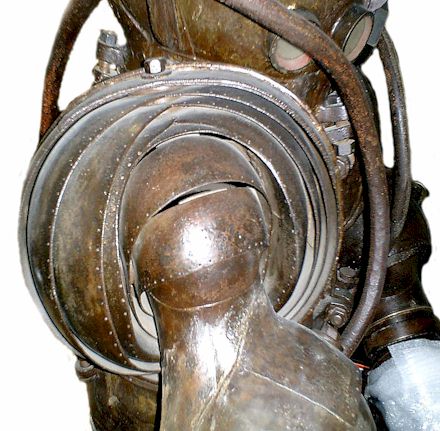
3)Articulation of the arms:
|
|
It is without any doubts the most admirable part of the device and these are yet these joints that condemned the diving suit of the brothers Carmagnole to be only a curiosity and that held it far from the depths toward which he/it was called.
The joints were of an ingenious principle: Clearly inspired by the medieval armors according to some Of the segments of spheres very finely manufactured slipped one on the other. A strip of cloth rubberized fixed the joint very close to assured the étanchéité.ajoutée to strips of pork skin (The inventors add that it is necessary to let hairs). one counts six of these joints articulated for every bras.Ces segments of spheres move around four pivots (vertical and horizontal visible on the illustration) The shells separated between them by disks can move therefore in four directions: Loud - Low, Rear - before. It is the complexity of the joints, their heaviness and their lack of tightness that made defect in spite of an impeccable realization and the hundreds of hours of machining perfectly achieved. The ball-bearings to facilitate the displacement of the pieces in the joints to kneecaps will come at the end of these problems but a lot of years later… The systems of tightness let therefore to want and one notes entries of water inside the diving suit. "They don't forgive because air contained in the enclosed surrounding wall is to the air pressure whereas water, it is naturally to an extensively superior pressure. Then the risk of replenishment of the dress, and of drowning for the diver becomes too big ".
He/it is very likely that the displacement of the members is in the case of this extremely difficult diving suit even out of water. "even though the tightness is assured correctly, the experience proves that, under water, the joint of the arms and legs is more and more hard under the effect of the pressure. The action to seize an object, and especially to move while putting the legs in movement, becomes by force a test that only the tried athletes can face. "
|
|
4)Taille:
One recovers between the thighs the same systems of disks
5)Jambes and chausses:
|
|
Conclusion
All authors agreed up to here to say that the two inventors of this diving suit had been inspired by medieval armors in the rooms of a museum. He/it seems me rather; after a survey deepened of this device that the two Marseillais have in fact drawn meadows of them, in the nature the answers to their questions. As each knows it; all answers are effectively in the nature and notably under the surface of the oceans. As curious as it can appear, observe a lobster and you will find the plans of an incredible submarine machine, army, protected, articulate. It is precisely what one makes the two fréreses. Beyond the incredible complexity of the construction of this diving suit, it is especially his/her/its beauty that touches us today.
Vincent Roc Roussey
Chronology
_ 1715: Device of Lethbridge
_ 1771: Device of Freminet
_ 1797: Machine of Klingert
_ 1808: Individual bell of the English Fullerton
_ 1809: Newt of Drieberg
_ 1838: Machine of Taylor
_ 1853: Submarine fisher of The Bateux
_ 1853: Diving suit of Bigard with breastplates, cuissards, leggings, mask fenced in metal.
_ 1855: Diving suit of Cabirol
_ 1856: Rigid diving suit drawing articulated of LD Philips
_ 1860: Aérophore of Rouquayrol and Denayrouse.
_ 1875: Metallic dress of Lafayette or subsisted human appearances some.
_ 1878: Conception of the rigid Diving suit articulated of the brothers Carmagnolle (According to Emile Condroyer in 1948)
_ 1882: Deposit of patent of the diving suit of the brothers Carmagnolle
_ 1892: Articulate diving suit of W. Carrey
_ 1920: Apparition of the first efficient rigid combinations.
_ After 1945: Development of the diving suit Cousteau Gagnant
Many thanks Vincent for your fantastic help with this article!
Return to part 1 of the Carmagnolle story Continue to part 3 of the Carmagnolle story